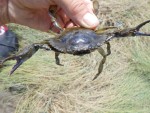As the ocean warms, marine species will begin to expand or migrate towards the poles. Forty-five minutes north of Boston, Massachusetts, scientists at the Plum Island Ecosystems (PIE) Long Term Ecological Research (LTER) site have seen new species arrive in the past three years.
In 2012, David Johnson – then a scientist at the Marine Biological Laboratory – found a blue crab, Callinectes sapidus, in the salt marsh. In a paper published this year in the Journal of Crustacean Biology, Johnson reports blue crabs being found as far north as Nova Scotia. The discovery was compelling because blue crabs are a warm-water species whose northern limit is Cape Cod, two hours to the south.
Two years later in 2014, Johnson found a fiddler crab, Uca pugnax in the muds of the PIE LTER. “When he popped out I said, ‘What are you doing here? You’re not supposed to be here,” Johnson recounted. Fiddler crabs have never been observed north of Boston before. They are now as far north as New Hampshire. Johnson hypothesizes that the warming waters of the Gulf of Maine, particularly in 2012 and 2013, are the reason for the recent extension of ranges.
Johnson credits the LTER system—which is built on the recognition that long-term and broad-scale research is necessary for truly understanding environmental phenomena—with enabling him to make these kind of observations. “For over a decade I have been in these marsh muds collecting invertebrates, so I know them pretty well. So when someone new shows up, I take notice,” Johnson says. He notes that by comparing all the environmental and biological data prior to the crab invasion to data taken after the invasion, PIE LTER is perfectly poised to track the trajectory of ecosystem-level responses and address questions related to how climate-driven range extensions will impact ecosystems.
Johnson’s observations at PIE LTER has been widely reported in national and international newspapers and respected science magazines such as Scientific American.

 Enlarge this image
Enlarge this image
